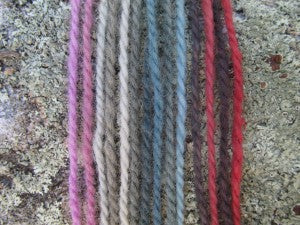
Before every workshop I often run a series of tests. I almost always check the dye potential of new collections, and lately I’ve run a few tests to confirm dye notions that I have learned from others.
In a previous post, I tested the oft told story called “Finite Number of Dye Molecules”. This story was told to me in the very first dye class I took, and I have heard it repeated and I have repeated it for years. It basically goes like this: There are a finite number of dye molecules in the dye-bath. Adding excessive water will not dilute the dye in any way. To make a dye less concentrated you must add more fiber.
While there may be merit to this story, I found that adding more water does affect the dye of Cortinarius semisanguineus. While it may not technically dilute it, adding different amounts of water will give you very different results.
Today I tested a couple more stories that I often tell. The first was “Mature Cortinarius semisanguineus dye better than younger specimens”, and the second “You don’t need mordants for lichen dyes”
The Cortinarius specimens tested were collected in the same patch at the same time, sorted by their maturity and dried. Using equal amounts of fungus to wool, the quality of dye from the younger specimens was noticeably deeper and more saturated than from the older specimens. Admittedly, there were variables in this crude test – like fractions of weight and shape of jar, but in this early stage I would say the observations beg for further investigation.
As for the lichen dyes, I used wool premordanted with alum and iron, and while I did see some difference, the quality of dye seem diminished with the use of mordants for this particular lichen. I have seen significant differences in the past performing this same test on Lobaria pulmonata (various shades of beige). Sofor the time being, I will keep this story and will continue to tell it with the mention of exclusions.
The other tests in the photo above were collection tests. I was expecting more color from the two Hydnellums that gave me grey and much less from the ones that gave me blue. Hydnellums can be tricky to identify, and even if you do get a name, it is a well known fact among taxonomists that there are several species parading around under a single (often European) name.
The fungus that produced the glorious blues goes by the name of Hydnellum pineticola, a mushroom that has both a good and bad dye resume. I lucked out with this collection and was stunned by its brilliant blue dye. Another surprise occurred when I pulled out the second dye-bath sample, and in only half the time it was brighter than the first!
It is a good rule of thumb to question the stories you hear and stories you tell, and to share your experiences with others. Who knows where these stories originate, but if we take the time to document our own findings rather than just believing what we are told, progress will be made not only in the world of mushroom dyes, but taxonomy and beyond.
